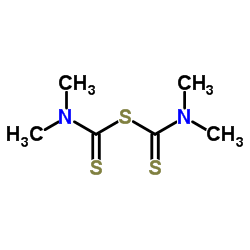Toxicity studies on tetramethylthiuram monosulfide.
O T Alanis, K J Freundt, G P Liebaldt
文献索引:Environ. Res. 28(1) , 199-211, (1982)
全文:HTML全文
摘要
Tetramethylthiuram monosulfide (TMTM), when given in a small dose of 26 mg/kg po, caused prolongation of the hexobarbital sleeping time in female Wistar rats. This effect was enhanced by increasing the dose to 867 mg/kg po and was associated with a lengthening of the zoxazolamine paralysis time. Both effects are causally related to an inhibition of the microsomal monooxygenases. One of the reasons for this inhibition conceivably is the concomitant decrease in the conversion of palmitic acid (incorporation of 14C radioactivity) into the phospholipids of the microsomal membrane. In contrast, other clinicochemical parameters of liver function detectable in the blood remained normal even after oral doses of 26 mg/kg TMTM administered on 5 consecutive days per week over a period of 4 weeks. However, this treatment caused a decrease in the erythrocyte count and hemoglobin content in the blood, together with a reduction of the relative liver weight, body weight, and the intake of food, while the consumption of drinking water was increased. Histologically, there was evidence of hepatocellular and renal tubular swelling. In female mice given acute oral doses of TMTM, the LD 50 was calculated as 818 (583–995) mg/kg. In mutagenicity tests, TMTM caused point mutations in strains TA 100 and TA 1535 ( Salmonella typhimurium LT 2). The results indicate that the toxic potential of TMTM is comparable to that of other thiurams. A tentative hygienic threshold limit of 5 mg/m 3 is proposed for the working environment.
相关化合物
| 结构式 | 名称/CAS号 | 分子式 | 全部文献 |
|---|---|---|---|
 |
一硫化四甲基秋兰姆
CAS:97-74-5 |
C6H12N2S3 |
|
New antimony(III) halide complexes with dithiocarbamate liga...
2016-01-01 [Mater. Sci. Eng. C. Mater. Biol. Appl. 58 , 396-408, (2015)] |
|
Occupational allergic contact dermatitis of the ears caused ...
2011-10-01 [Contact Dermatitis 65(4) , 242-3, (2011)] |
|
Enzyme inhibition as a possible mechanism of the mutagenicit...
1984-05-01 [Chem. Biol. Interact. 49(3) , 329-40, (1984)] |
|
Elicitation thresholds for thiuram mix using petrolatum and ...
1996-06-01 [Contact Dermatitis 34(6) , 410-3, (1996)] |
|
Allergic contact dermatitis of the eyelids from rubber chemi...
1991-02-01 [Contact Dermatitis 24(2) , 145-6, (1991)] |